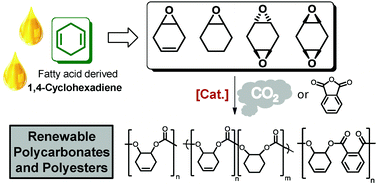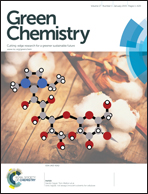Renewable polycarbonates and polyesters from 1,4-cyclohexadiene†
Abstract
Epoxides derived from 1,4-cyclohexadiene (CHD), the latter produced from renewable resources via self-metathesis of plant oil derivatives, are applied as key substrates in ring-opening copolymerizations to produce aliphatic polycarbonates and polyesters. Renewable, unsaturated polycarbonates are prepared by the ring-opening copolymerization of epoxide/CO2; these are catalysed by di-zinc/magnesium complexes previously reported by Williams et al. or by using chromium(III) or cobalt(III) salen complexes. Renewable, unsaturated polyesters, with glass transition temperatures up to 128 °C, were obtained by the ring-opening copolymerization of epoxide/phthalic anhydride. The relative rates of these copolymerizations were monitored using in situ attenuated total reflectance infra-red (ATR-IR) spectroscopy. The polymers were fully characterized using spectroscopy (nuclear magnetic resonance, infra-red), mass spectrometry (matrix assisted laser desorption ionization), and by thermal methods (differential scanning calorimetry and thermogravimetric analysis).

- This article is part of the themed collection: 2015 most accessed Green Chemistry articles

 Please wait while we load your content...
Please wait while we load your content...